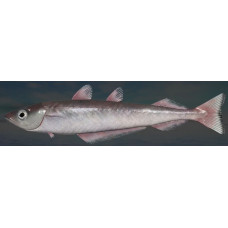Latin name
Micromesistius poutassou
Other names
Merluci blu (Albanian), Kék puha tőkehal (Hungarian), Blauwe wijting (Dutch), Προσφυγάκι (Prosfygaki) (Greek), Bacaladilla (Spanish), Melù (Italian), Blauer Wittling (German), Błękitek (Polish), Verdinho (Portuguese), Pichelim (Romanian), Ugotica pečinka, Ugotica pučinska (Serbian, Croatian), Sinji mol (Slovenian), Mavimezgit balığı (Turkish), Merlan bleu (French).
Identification
The body is elongated and covered with very small, slightly falling cycloid scales. There is no moustache on the chin. There is a large gap between the three dorsal fins. There are 11-15 soft rays on the first and second dorsal fins and 20-27 soft rays on the third. The first anal fin is very long with 31-39 soft rays and the second with 22-29 soft rays. Caudal fin with small notch. The small pelvic fins are in front of the pectoral fins. The back is grey-blue, the sides are silvery and the belly is white. There is sometimes a small dark spot at the base of the pectoral fins.
Distribution
In the northeastern part of the Atlantic Ocean, it is distributed from the western part of the Mediterranean Sea to Iceland. It is found in the Baltic Sea, the northern and western parts of the Barents Sea and near Svalbard. In the northwestern Atlantic it is found from Nova Scotia to southern Greenland.
Habitat
Pelagic, cold-loving. During the day it stays at the depths, at night it comes to the surface.
Size
It grows slowly, reaching a length of 30-35 cm at the age of 8-10 years. It can reach a length of 55 cm, but its usual length is 30-35 cm.
Life history and Behavior
The migration is semi-transient. It breeds in the southern part of its range, mainly at a depth of 180-300 m and deeper, at a water temperature of 8-10°.
Food and feeding habits
It feeds on planktonic crustaceans, as well as larvae and young fish — luminous anchovies, herring, cod and other species. In turn, the whiting itself serves as food for cod, haddock and marine mammals such as pilot whale and common dolphins.
Reproduction
It matures for the first time at the age of 2-4 years with a body length of 17-20 cm, usually 23-26 cm. It breeds in the southern part of its range, mainly at a depth of 180-300m and deeper, at a water temperature of 8-10°. It spawns in portions. The caviar is pelagic, developing in the bottom layers. The larva and juvenile are pelagic, carried by ocean currents in the upper layers of water above depths of 1000 m.
| Classification | |
| Phylum | Chordata |
| Class | Actinopterygii |
| Squad | Gadiformes |
| Family | Gadidae |
| Genus | Micromesistius |
| Species | M. poutassou |
| Features | |
| Conservation status | Least Concern |
| Habitat | Pelagic |
| Life span, years | 10 |
| Maximum body weight, kg | 0,5 |
| Maximum length, cm | 55 |
| Threat to people | Edible |
| Way of eating | Predator |
Blue whiting
Tags: blue whiting


